中国物流发展报告-蓝皮书 英文版 第七章
- 格式:pdf
- 大小:116.03 KB
- 文档页数:7
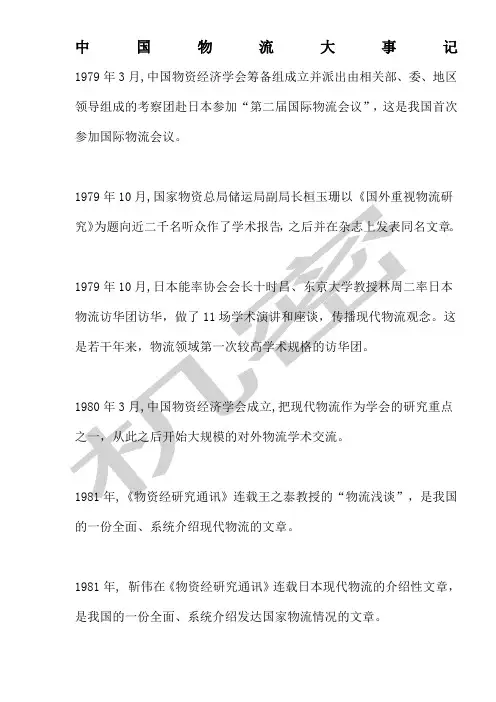
中国物流大事记1979年3月,中国物资经济学会筹备组成立并派出由相关部、委、地区领导组成的考察团赴日本参加“第二届国际物流会议”,这是我国首次参加国际物流会议。
的一份全面、系统介绍现代物流的文章。
1981年, 靳伟在《物资经研究通讯》连载日本现代物流的介绍性文章,是我国的一份全面、系统介绍发达国家物流情况的文章。
1981年,《物资流通技术》杂志创刊,该杂志以物流技术为主要选题,是我国第一个这个领域的科技类型杂志。
1984年8月,国家计委柳随年副主任担任会长的“中国物流研究会”书籍。
1986年,黑龙江商学院专门研究储运装备的杂志改称《物流科技》,这是我国第一个以“物流”学科为名称的杂志。
1987年,经济科学出版社出版署名为李京文、徐寿波、吴润涛、王之泰的专著《物流学及其应用》,这是我国第一个以“学”的名义出版的物流专著。
,211990年,北京科技大学成立以吴清一教授为首的“物流研究中心”,这是我国第一个以“物流”为学科名称的正式研究机构。
1990年7月,中国物流研究会撤销,合并到新成立的中国物资流通学会之中,中国物资流通学会以“物流技术经济委员会”名义,继续进行物流的学术研究活动。
1991年, 《物资流通技术》杂志正式更名为《物流技术》杂志,杂志主编为王为民。
,1994年,我国第一个民间资本创建的第三方物流企业—宝供物流公司在广州成立,并成功地承担美国宝洁公司产品在中国大陆的分销物流。
1995年4月,东风汽车公司推出了我国第一家企业物流杂志《东风物流》,该杂志主编为李学诗。
1995年6月,国家第八个五年计划重点出版物,王之泰著的《现代物流学》由中国物资出版社出版。
1999年底,中国第一个物流专业网站《中国物流网》开通。
2000年5月,中共深圳市第三次党代会将现代物流确定为深圳市三大重要支柱产业之一。
是我国第一个将现代物流确定为国民经济的“重要支柱产业”的地区。
2000年,深圳市编制发布《深圳市“十五”及2015年现代物流发展规划》, 这是我国第一个区域性的物流规划,2001年,我国“十五”规划,物流被列为要大力发展的新型服务业之2001年初,上海市发布《上海市“十五”现代物流产业发展规划》,把上海市定位为“国际物流中心”。
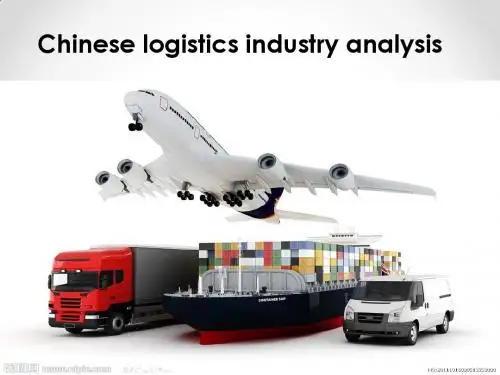

2009-2010年中国物流行业研究报告纸介版价格:4000元/篇页数:105页完成日期:2010-06-09电子版价格:4500元/篇纸介版+电子版价格:元联系方式:0086-21-64871266 网址:2009-2010年中国物流行业研究报告摘要2009年中国社会物流总额共计96.65万亿元,同比增长7.5%。
2009年各季度社会物流总额增长速度逐渐加快,并在2009年第三季度由下降转为上升,累计增长2%。
这说明2009年中国物流行业在经济复苏的带动下,开始企稳回升。
2010年一季度中国社会物流总额为25.9万亿元,按可比价格计算,同比增长20.8%,预计2010年全年中国物流行业将保持快速增长态势。
图:2009年各季度社会物流总额及增长率(累计)来源:中国物流与采购联合会2009年中国共完成货运量274.4亿吨,同比增长12.2%;完成货运周转量119188.5亿吨公里,同比增长15.2%。
从不同交通运输方式来看,公路货运仍然是主力。
2009年公路货运量为209.7亿吨,占总货运量的76.41%;铁路和水路货运量各占总货运量的12.13%和11.44%;而航空货运仅占总货运量的0.02%。
图:2009年中国各种交通运输方式所占货运量比例情况整理:水清木华研究中心2010年中国铁路基建计划投资7000元,轨道建设规划长度450公里,高于2009年水平。
铁路及轨道建设能够极大地提高铁路货运能力,再加上铁路具有运输成本低、货运数量大的优点,未来铁路货运在货运总量中的份额将逐渐上升。
本报告分别介绍了铁路货运、公路货运、航空货运、水路货运的现状和未来方向,同时分析了汽车物流、钢铁物流、石化物流、医药物流、煤炭物流、家电物流的发展趋势及代表性企业。
最后,为了更全面深入的了解中国物流行业,本报告研究了最有代表性的17家综合性物流企业。
正文目录第一章中国物流行业整体发展情况1.1 物流行业界定1.2 中国物流行业发展现状1.2.1 社会物流总额1.2.2 社会物流总费用1.2.3 物流业增加值1.2.4 货运情况1.3 2009年物流行业发展特点第二章中国物流行业发展环境分析2.1 政策环境2.2 经济环境2.2.1 GDP2.2.2 进出口2.3 交通环境2.3.1 公路建设2.3.2 水运建设第三章中国交通运输货运行业发展状况3.1 铁路货运3.1.1 中国铁路货运情况3.1.2 中国铁路货运发展方向3.2 公路货运3.2.1 中国公路货运情况3.2.2 中国公路货运发展方向3.3 航空货运3.3.1 中国航空货运情况3.3.2 中国航空货运发展方向3.4 水路货运3.4.1 中国水路货运情况3.4.2 中国水运发展方向第四章汽车物流4.1 汽车物流发展现状4.2 汽车物流运输模式4.3 汽车物流发展趋势4.4 汽车物流重点企业4.4.1 安吉天地汽车物流公司(ANJI TNT Automotive Logistics Co.,Ltd.)4.4.2 中铁特货(China Railway Special Cargo Services Co., Ltd.)第五章钢铁物流5.1 钢铁物流发展现状5.2 钢铁物流模式5.3 钢铁物流发展趋势5.4 钢铁物流重点企业5.4.1 五矿物流(Minmetals Logistics Group co.,LTD)5.4.2 百科集团(B&K Group)第六章石化物流6.1 石化物流发展现状6.2 石化物流业务类型6.3 石化物流重点企业6.3.1 长航油运(NANJING TANKER CORPORATION)6.3.2 中化国际(Sinochem International Corporation)第七章家电物流7.1 家电物流发展现状7.2 家电物流发展趋势7.3 家电物流重点企业7.3.1 安泰达物流(Attend Logistics)7.3.2 安得物流(ANNTO)第八章煤炭物流8.1 煤炭物流发展现状8.2 煤炭物流重点企业8.2.1 大秦铁路(DAQIN RAILWAY CO.,LTD)第九章医药物流9.1 医药物流发展现状9.2 医药物流发展趋势9.3 医药物流重点企业9.3.1 九州岛通医药集团(JOINTOWN PHARMACEUTICAL GROUP)9.3.2 国药集团医药物流有限公司(Sinopharm Logistics Co.,Ltd)第十章重点区域物流发展分析10.1 长三角10.1.1 长三角物流业发展现状10.1.2 长三角物流业存在的问题10.1.3 长三角经济圈重点省市物流业发展展望10.2 泛珠三角10.2.1 泛珠三角物流发展现状10.2.2 泛珠三角经济圈物流业发展优势10.2.3 泛珠三角经济圈重点省市物流业发展情况10.3 环渤海湾10.3.1 环渤海湾物流业发展现状10.3.2 环渤海经济圈重点省市物流业发展情况第十一章综合物流企业分析11.1 UPS11.1.1 公司简介11.1.2 经营状况11.1.3 亚洲转运中心顺利运营11.2 FEDEX11.2.1 公司简介11.2.3 加大中国市场投入11.3 DHL11.3.1 公司简介11.3.2 经营状况11.4 宝供物流(P.G.LOGISTICS GROUP CO., LTD)11.5 中国外运(SINOTRANS LTD)11.5.1 公司简介11.5.2 经营状况11.6 中国远洋(COSCO LOGISTICS)11.6.1 公司简介11.6.2 经营情况11.7 中海集团(CHINA SHIPPING GROUP)11.7.1 公司简介11.7.2 经营状况11.8 上港集团(SIPG)11.8.1 公司简介11.8.2 经营情况11.9 宁波海运(NINGBO MARINE COMPANY LIMITED)11.9.1 公司简介11.9.2 经营情况11.10 飞马国际(FEIMA)11.10.1 公司简介11.10.2 经营情况11.11 中储股份 ZHONG CHU DEVELOPMENT STOCK CO.,LTD11.11.1 公司简介11.11.2 经营情况11.11.3 发展前景11.12 招商轮船(CHINA MERCHANTS ENERGY SHIPPING CO.,LTD)11.12.1 公司简介11.12.2 经营情况11.13 长江投资(Y.U.D. YANGTZE RIVER INVESTMENT INDUSTRY CO.,LTD.)11.13.1 公司简介11.13.2 经营情况11.14 怡亚通(ETERNAL ASIA)11.14.1 公司简介11.14.2 经营情况11.15 铁龙物流 CHINA RAILWAY TIELONG CONTAINER LOGISTICS CO.,LTD.11.15.1 公司简介11.15.3 发展前景11.16 新宁物流 XINNING LOGISTICS11.16.1 公司简介11.16.2 经营情况11.16.3 发展前景11.17 宅急送(ZJS EXPRESS)第十二章中国物流行业发展趋势分析12.1 中国物流行业存在的问题12.2 发展趋势部分图表目录图:2006-2009年中国社会物流总额表:2009年中国社会物流总额构成图:2006-2009年中国社会物流总费用表:2009年社会物流总费用图:2006-2009年中国物流业增加值表:2009年中国物流业增加值图:2006-2009年中国货运总量图:2006-2009年中国货运周转量表:中国物流行业相关政策图:2007-2010年中国GDP走势图图:2004-2009年中国社会物流成本占GDP比重表:2010年第一季度分洲别进出口总值表:2010年第一季度中国进出口总值分地区排名表:2010年4月全国进口重点商品量值表表:2010年4月全国出口重点商品量值表表:2010年1-4月中国进出口简要情况表表:中国公路“十一五”规划目标表:全国内河航道与港口布局规划方案表:中国水路“十一五”规划目标表:各种交通运输方式优缺点比较图:2006-2009年中国铁路货运量图:2006-2009年中国铁路货物周转量表:2009年中国主要产品铁路货运量表:2008-2011年中国铁路基建投资情况表:2009-2010年计划完工铁路图:2006-2009中国公路货运量表:2009-2010年中国公路货运月度平均价格图:2006-2009年中国民航货运量图:2006-2009年中国水运货运量图:2006-2009年中国水运货物周转量表:2010年1月中国沿海(散货)平均运价表:主要汽车厂商物流模式表:中铁特货运输车类型及数量表:中国钢材流通渠道表:2009年五矿物流经营情况图:2005-2010年百科集团营业收入图:2005-2010年百科集团净利润图:1998-2008年中国化学品产值占总产值比例表:石化物流公司参与的物流环节图:2005-2010年长航油运总收入图:2005-2010年长航油运净利润表:2009-2013年长航油运运力情况图:2005-2010年中化国际总收入图:2005-2010年中化国际净利润表:2009年中化国际分业务收入情况表:中国重点家电厂商及销售商物流公司图:2006-2009年安得物流营业收入图:2006-2009年安得物流净利润表:2006-2009年安得物流主营业务收入构成图:2005-2010年大秦铁路营业收入图:2005-2010年大秦铁路净利润图:2007-2009年国药物流销售收入图:2007-2009年国药物流利润总额表:2008-2009年度中国物流园区分区域排名表:2009年长三角各港口集装箱吞吐量完成情况表:2009年1-11月泛珠三角重点港口货物吞吐量表:2009年5月泛珠三角地区各省市累计货运量表:2009年1-11月环渤海湾重点港口货物吞吐量表:2009年5月环渤海地区各省市累计货运量表:2009年中国物流企业按业务收入排前10强名单表:UPS在中国市场的业务进程图:2005-2009年UPS总收入图:2005-2009年UPS净利润图:2005-2009年FedEx营业收入图:2008-2009年FedEx分部门收入及利润表:2008-2009年DHL营业收入图:宝供物流运作网络表:2008-2009年中国外运各业务运营情况图:2005-2009年中国外运营业额图:2005-2009年中国外运税前利润表:2009年中国外运分业务营业额比重图:2005-2010年中国远洋营业收入图:2005-2010年中国远洋净利润表:2008-2010年中国远洋集运业务分航线运输收入表:2008-2010年中国远洋集运业务分航线运量表:2008-2010年中海集团下属公司收入情况图:2005-2010年上港集团营业收入及净利润表:2009年上港集团主营业务收入构成图:2005-2010年宁波海运营业收入及净利润表:2009年宁波海运分业务收入构成图:2005-2010年飞马国际营业收入及净利润表:2009年飞马国际分地区业务收入构成图:2005-2009年中储股份主营业务收入图:2005-2009年中储股份净利润表:2010年中储股份定向增发募集资金项目图:2005-2010年招商轮船营业收入及净利润表:2009年招商轮船分业务收入情况表:2010年干散货分船型即期市场TCE 运价图:2005-2010年长江投资营业收入及利润图:2005-2010年怡亚通营业收入及利润表:2004-2010怡亚通物流业务经营情况表:2009年铁龙物流各项业务收入占比图:2005-2010年铁龙物流主营业务收入图:2005-2010年铁龙物流净利润图:2006-2009年新宁物流主营业务收入图:2006-2009年新宁物流净利润表:2009年新宁物流主营业务收入比重图:2009年新宁物流分区域主营业务收入比重表:新宁物流投资项目表:2010年上半年中国建成集装箱中心站列表。

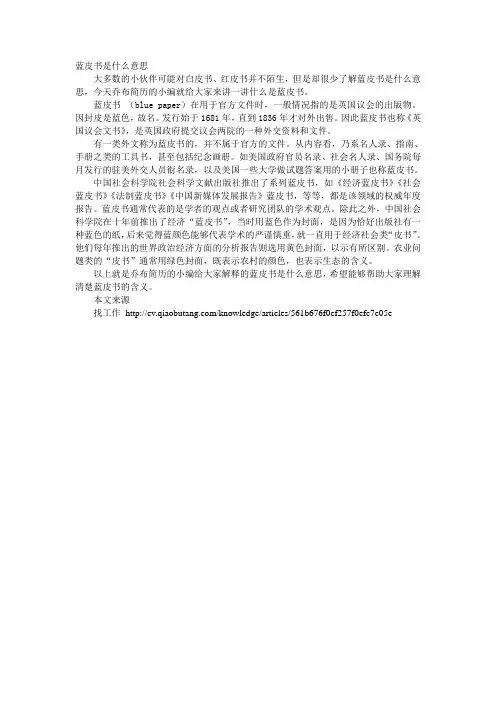
蓝皮书是什么意思
大多数的小伙伴可能对白皮书、红皮书并不陌生,但是却很少了解蓝皮书是什么意思,今天乔布简历的小编就给大家来讲一讲什么是蓝皮书。
蓝皮书(blue paper)在用于官方文件时,一般情况指的是英国议会的出版物。
因封皮是蓝色,故名。
发行始于1681年,直到1836年才对外出售。
因此蓝皮书也称《英国议会文书》,是英国政府提交议会两院的一种外交资料和文件。
有一类外文称为蓝皮书的,并不属于官方的文件。
从内容看,乃系名人录、指南、手册之类的工具书,甚至包括纪念画册。
如美国政府官员名录、社会名人录、国务院每月发行的驻美外交人员衔名录,以及美国一些大学做试题答案用的小册子也称蓝皮书。
中国社会科学院社会科学文献出版社推出了系列蓝皮书,如《经济蓝皮书》《社会蓝皮书》《法制蓝皮书》《中国新媒体发展报告》蓝皮书,等等,都是该领域的权威年度报告。
蓝皮书通常代表的是学者的观点或者研究团队的学术观点。
除此之外,中国社会科学院在十年前推出了经济“蓝皮书”,当时用蓝色作为封面,是因为恰好出版社有一种蓝色的纸,后来觉得蓝颜色能够代表学术的严谨慎重,就一直用于经济社会类“皮书”。
他们每年推出的世界政治经济方面的分析报告则选用黄色封面,以示有所区别。
农业问题类的“皮书”通常用绿色封面,既表示农村的颜色,也表示生态的含义。
以上就是乔布简历的小编给大家解释的蓝皮书是什么意思,希望能够帮助大家理解清楚蓝皮书的含义。
本文来源
找工作/knowledge/articles/561b676f0cf257f0efc7c05e。
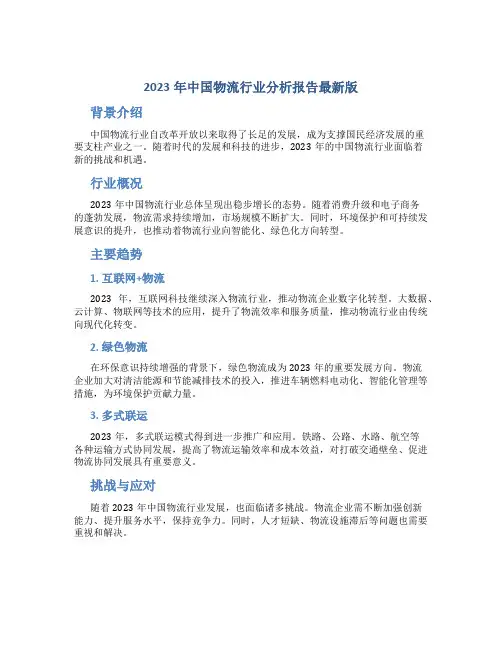
2023年中国物流行业分析报告最新版背景介绍中国物流行业自改革开放以来取得了长足的发展,成为支撑国民经济发展的重要支柱产业之一。
随着时代的发展和科技的进步,2023年的中国物流行业面临着新的挑战和机遇。
行业概况2023年中国物流行业总体呈现出稳步增长的态势。
随着消费升级和电子商务的蓬勃发展,物流需求持续增加,市场规模不断扩大。
同时,环境保护和可持续发展意识的提升,也推动着物流行业向智能化、绿色化方向转型。
主要趋势1. 互联网+物流2023年,互联网科技继续深入物流行业,推动物流企业数字化转型。
大数据、云计算、物联网等技术的应用,提升了物流效率和服务质量,推动物流行业由传统向现代化转变。
2. 绿色物流在环保意识持续增强的背景下,绿色物流成为2023年的重要发展方向。
物流企业加大对清洁能源和节能减排技术的投入,推进车辆燃料电动化、智能化管理等措施,为环境保护贡献力量。
3. 多式联运2023年,多式联运模式得到进一步推广和应用。
铁路、公路、水路、航空等各种运输方式协同发展,提高了物流运输效率和成本效益,对打破交通壁垒、促进物流协同发展具有重要意义。
挑战与应对随着2023年中国物流行业发展,也面临诸多挑战。
物流企业需不断加强创新能力、提升服务水平,保持竞争力。
同时,人才短缺、物流设施滞后等问题也需要重视和解决。
未来展望展望未来,2023年中国物流行业将持续朝着智能化、绿色化、网络化的方向发展。
随着科技不断创新和应用,中国物流行业有望在全球舞台上展现更加强大的竞争力。
结语综上所述,2023年中国物流行业将以创新的方式应对挑战,迎接机遇,实现可持续发展。
希望本报告对行业发展和相关从业者有所启发和帮助。
以上观点仅供参考,具体情况请以实际为准。
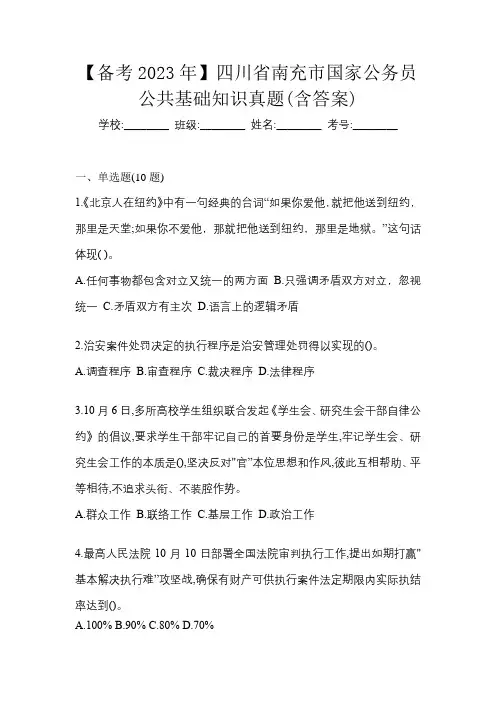
【备考2023年】四川省南充市国家公务员公共基础知识真题(含答案) 学校:________ 班级:________ 姓名:________ 考号:________一、单选题(10题)1.《北京人在纽约》中有一句经典的台词“如果你爱他,就把他送到纽约,那里是天堂;如果你不爱他,那就把他送到纽约,那里是地狱。
”这句话体现( )。
A.任何事物都包含对立又统一的两方面B.只强调矛盾双方对立,忽视统一C.矛盾双方有主次D.语言上的逻辑矛盾2.治安案件处罚决定的执行程序是治安管理处罚得以实现的()。
A.调查程序B.审查程序C.裁决程序D.法律程序3.10月6日,多所高校学生组织联合发起《学生会、研究生会干部自律公约》的倡议,要求学生干部牢记自己的首要身份是学生,牢记学生会、研究生会工作的本质是(),坚决反对"官”本位思想和作风,彼此互相帮助、平等相待,不追求头衔、不装腔作势。
A.群众工作B.联络工作C.基层工作D.政治工作4.最高人民法院10月10日部署全国法院审判执行工作,提出如期打赢"基本解决执行难”攻坚战,确保有财产可供执行案件法定期限内实际执结率达到()。
A.100%B.90%C.80%D.70%5.联合国教科文组织总干事博科娃在2013年11月25日举行的第六届世界科学论坛上.向中国科学家李象益颁发了( )。
A.科学奖B.卡林加奖C.卡洛斯.J.芬利奖D.贾韦德.胡赛因青年科学家奖6.国家药监局负责人2018年7月22日通报长春长生生物科技有限责任公司违法违规生产冻干人用( )疫苗案件有关情况。
国家药监局已责令企业停止生产,收回药品GMP证书,召回尚未使用的( )疫苗。
A.狂犬病B.卡介苗C.百白破三联D.麻疹7.()成功推翻了统治中国二百六十多年的清王朝,结束了中国两千多年的封建君主专制制度,开启了民主共和的新纪元。
A.土地革命B.解放战争C.辛亥革命D.武昌起义8.中国社科文献出版社及廉思课题组2013年6月8日在北京发布青年蓝皮书《中国青年发展报告(2013)),提出了“拐点一代”的论断。
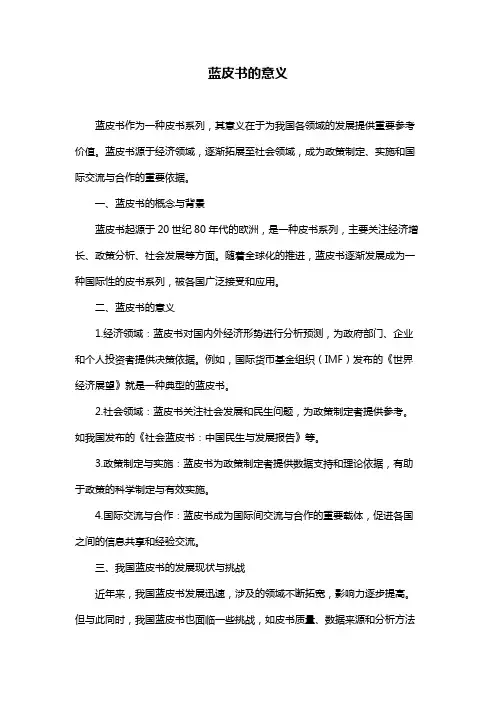
蓝皮书的意义
蓝皮书作为一种皮书系列,其意义在于为我国各领域的发展提供重要参考价值。
蓝皮书源于经济领域,逐渐拓展至社会领域,成为政策制定、实施和国际交流与合作的重要依据。
一、蓝皮书的概念与背景
蓝皮书起源于20世纪80年代的欧洲,是一种皮书系列,主要关注经济增长、政策分析、社会发展等方面。
随着全球化的推进,蓝皮书逐渐发展成为一种国际性的皮书系列,被各国广泛接受和应用。
二、蓝皮书的意义
1.经济领域:蓝皮书对国内外经济形势进行分析预测,为政府部门、企业和个人投资者提供决策依据。
例如,国际货币基金组织(IMF)发布的《世界经济展望》就是一种典型的蓝皮书。
2.社会领域:蓝皮书关注社会发展和民生问题,为政策制定者提供参考。
如我国发布的《社会蓝皮书:中国民生与发展报告》等。
3.政策制定与实施:蓝皮书为政策制定者提供数据支持和理论依据,有助于政策的科学制定与有效实施。
4.国际交流与合作:蓝皮书成为国际间交流与合作的重要载体,促进各国之间的信息共享和经验交流。
三、我国蓝皮书的发展现状与挑战
近年来,我国蓝皮书发展迅速,涉及的领域不断拓宽,影响力逐步提高。
但与此同时,我国蓝皮书也面临一些挑战,如皮书质量、数据来源和分析方法
等方面仍有待提高。
四、蓝皮书的未来发展趋势与展望
随着大数据、人工智能等技术的发展,未来蓝皮书将更加注重数据挖掘和分析,形成更加精准、具有预见性的研究成果。
同时,蓝皮书的国际影响力将进一步扩大,成为全球关注的皮书系列。
191B.-l. Liu et al. (eds.), Contemporary Logistics in China: Transformation and Revitalization , Current Chinese Economic Report Series, DOI 10.1007/978-3-642-33567-9_7, © Springer-Verlag Berlin Heidelberg 2013The year of 2011 had wrought much complexity to China’s economic situation. On the one hand, China accelerated its transformation of economic development mode and promoted the strategic adjustment of economic structure, leading to a rapid and steady development of its national economy. On the other hand, by posi-tively implementing the A djustment and Revitalization Plan for Logistics Industry issued in 2009 by the State Council and promulgating a number of policy docu-ments to promote industrial transfer and restructuring as well as construction of the rural circulation system, governments at all levels created a favorable macro envi-ronment for a holistic and rapid development of its logistics industry. This chapter provides a summary of the discussions in the preceding chapters, and offers some conclusions and an outlook for the logistics development in China.7.1 D evelopment Environment of China’s Logistics In term of economic environment in 2010, the growth in international trade rapidly recovered from the aftermath of the global fi n ancial crisis and the domestic logistics demand rose steadily as well. Since China has continued to increase the input in transport infrastructure in recent years, the construction of logistic infrastructure has seen some tangible results and an integrated transport system has taken shape. However, due to in fl a tion the cost of various production factors also hiked percepti-bly, posing a mounting cost pressure on the logistics enterprises.L . W ang (*)L ogistics Research Center ,N ankai University ,N o.94 Weijin Rd. ,N ankai District T ianjin 300071 ,P .R. Chinae -mail: wlnk3006@C hapter 7C onclusions and OutlookL ing W ang192L. WangI n term of policy environment, in 2010, relevant departments and governments at all levels developed special plans and local ordinances for implementing the general stipulations set by the A djustment and Revitalization Plan for Logistics Industry. The Central Government also introduced measures to speed up the construction of rural and agricultural circulation system, giving great importance to the rural mar-ket. All these measures provide the necessary policy assurance for the development of China’s logistics. In the meantime, China successively put forward a number of documents to promote industrial transfer and restructuring and provide guidance for logistics development. A noticeable move is the enactment of the E conomic Cooperation Framework Agreement(ECFA), of fic ially coming into effect in 2010, which has greatly promoted the rapid development of trade and logistics across the Straits.7.2 D evelopment of China’s Logistics MarketA long with the recovery of domestic and international macro economy, China’s logistics market also rapidly rebounded in 2010; the total social logistics expenses, port throughput and container throughput, etc. all saw signi fic ant growth over 2009, and they even surpassed the development levels of 2007–2008 peak years prior to the global fin ancial crisis.I n term of logistics demand in 2010, since the international logistics market rebounded swiftly from the decline, the logistics volume of bulk energy and raw material remained high; the markedly accelerated demand in logistics market in the Central and Western China drove the development of logistics service in these regions; auto, online shopping, cold chain for food and other markets all showed high rates of growth and emergency logistics also began to take shape.I n term of logistics supply in 2010, the overall concentration of the logistics industry was still low; foreign enterprises continued to fortify their network con-struction, actively engaged in emerging logistics market segments, expanded the local customers base, and competed with the local enterprises. Domestic logistics enterprises were striving to improve their market competitiveness by direct fin ancing and improving their service network.7.3 D evelopment Trend of China’s Logistics InfrastructureI n 2010, China’s investment in logistics infrastructure, particularly in transport infrastructure, reached its highest level over the years. With strong support from the Government’s massive investment, China’s railway, highway, waterway, airport and other transport infrastructures have seen signi fic ant improvement in both scale and technology, and the network structure was further optimized to sustain the growing logistics market. In the meantime, China also made rapid progress in professional193 7 Conclusions and Outlookstorage facilities, bonded logistics centers, professional logistics centers and public logistics information platforms. As a result, China’s logistics infrastructure has seen marked improvements both in scale and in quality.7.4 D evelopment of China’s Regional LogisticsI n 2010, China strategically promoted the formulation of development plans for the major economic regions and established the development pattern comprising the Eastern, Northeastern, Central and Western regions, each with its own focus. Several of these areas have been given special attention recently due to their unique attri-butes and strategic importance; their logistics development is vital to China’s over-all economic growth. Speci fic ally, the Chengdu – Chongqing Economic Zone has evolved into an important economic powerhouse in the Western region; Xinjiang is playing an increasingly important role in China’s international trade along Asian boarder by virtue of its unique advantages in geographical location and natural resources; the Zhongyuan City Cluster has become the signi fic ant grain production base, energy and raw material base and modern equipment manufacturing and high-tech industry base; the Northeastern region has long been China’s heavy industry base and grain production base and has recently witnessed a rapid growth in logistics development. Therefore, this book has chosen these regions as examples to highlight China’s regional logistics development.F rom 2006 to 2010, China continued to pursue its “Grand Western Development” strategy and industries in the Eastern region continued to migrate to the Western region in an accelerated pace. Relying on its solid industrial base, dominant loca-tional advantage and complete and integrated transportation network, the Chengdu – Chongqing Economic Zone has achieved rapid progress in logistics development. The upgrade in industry and shift of industry from East to West expanded the demand in logistics market for the Zone and facilitated its market development. By virtue of its favorable location, the infrastructures in railway, highway, waterway and airport were further improved, and a number of logistics parks and centers were established. In addition, the IT application in logistics also saw improvement. All these advancements helped the Chengdu-Chongqing Economic Zone to become an economic and logistics powerhouse.U nique advantages in location and natural resources as well as policy support from the Central Government provide an important foundation for Xinjiang to accelerate its economic development and rationalize its industrial structure. In term of logistics market, Xinjiang is the international passage for China to import energy and scarce mineral resources and is gradually developing into the processing base, transit distribution center and logistics passage for China’s opening-up to the West, thus playing a strategic position in promoting the economic cooperation between China and the Central Asian countries. Meanwhile, as the New Eurasia Continental Bridge traverses Xinjiang, port logistics has become an important feature in Xinjiang’s logistics development. With improved logistics facilities and policy194L. Wang environment, port logistics in Xinjiang develops quickly as well. Urumqi, Kashgar, Ala Mountain pass, Khorgos and other nodes are playing an increasingly important role in regional trade between China and Middle Asia, West Asia, Russia and Mongolia.T he rapid development of regional economy, the adjustment and improvement of industrial structure and in particular, the fast expansion of consumer market together provide favorable economic base and huge market space for the logistics develop-ment of the Zhongyuan city cluster. Recently, the logistics market of the Zhongyuan city cluster has expanded rapidly; its logistics industry and major logistics enter-prises have also grown substantially. In particular, its kernel city, Zhengzhou, as the comprehensive transport hub which has the potential to develop into an inland inter-national logistics center in Zhongyuan city cluster is much highlighted.U nder the more slack money policy and the expansion fis cal policy of the State, the Northeastern region has achieved signi fic ant growth in regional economic aggregate, total sales of social consumer goods and foreign trade. In the region, the logistics market is continually expanded, the logistics and transport infrastructures (railway infrastructure in particular) are well developed and the construction of logistics parks continues to make progress. Promoted by the Government and regional economic integration, the progress of regional logistics integration also continues to advance. In addition, since the Northeastern region serves as China’s heavy industry base and grain base, its manufacturing logistics and grain logistics attain rapid development as well.7.5 D evelopment of China’s Industrial LogisticsT his section mainly analyzed the market segments of industry with large logis-tics demand and high degree of logistics operational specialization. Since fresh agricultural products are perishable, their logistics characteristics are quite dif-ferent from goods transported at room temperature, thus professional logistics operations are needed to handle them. China is the largest coal producer and consumer in the world, so coal logistics plays an important part in bulk commod-ity logistics market. Express service is also a much specialized market segment for logistics. In 2011, China’s express market ranked No.3 in the world, after the U.S. and Japan. Therefore, Chap. 5of the book is devoted to the development trend of China’s logistics regarding fresh agricultural products, coal and express service.W ith the constant increase in the distribution scale of China’s agricultural products logistics, the market trading volume and turnover also grew year by year. The logistics infrastructure for agricultural products continues to be improved, the network of green channels has been constructed and the operational level is being promoted gradually. Self-managed logistics mode and third party logistics mode are in simultaneous development. Third party logistics enterprises, especially cold chain logistics enterprises, have evolved into the principal party. However, China’s195 7 Conclusions and Outlookfresh agricultural products logistics is also challenged by such defects as low logistics ef fic iency, high circulation loss and backward facilities and equipment, especially in cold chain logistics development.C hina’s coal industry features the transport pattern of “transporting coal from west to east and from north to south.” Channels for coal logistics have gradually taken shape in China; construction of coal logistics park, coal railway and other infrastructures is in an accelerated stage; integration of logistics resources of coal enterprises has been further enhanced. However, insuf fic ient transport capacity of coal railway is still the “bottleneck” which restricts the outbound transport of coal. In addition, the market level of coal logistics is low; many large-scale coal enterprises adopt the traditional integrated self-operating mode, which follows the “production + transport + sales” pattern; the resource integration of coal logistics is also insuf fic ient.T he continued improvement of China’s express service management system and the formulation of a number of new express service standards, related laws, regulations and plans have further upgraded the express service in China. At present, the service capability of China’s express enterprise has been greatly improved. The business entity in China’s express market begins to show a diversi fic ation trend, and a market competition pattern featuring co-existence of state-owned, private and foreign–funded express enterprises has taken shape. As market competition intensi fie s, merger and acquisition begin to occur among different express enter-prises. However, there are still some problems with China’s express logistics. For example, policy treatment for enterprises with different ownerships varies, the market’s response capacity is low, most of domestic enterprises have relatively backward internal management level, etc.7.6 H ot Issues in China’s Logistics DevelopmentC hapter 6of the book describes some major issues or hot issues regarding logistics in China’s economic and social fil ed. Since China’s accession to the WTO 10 year ago, international trade has contributed greatly to the rapid development of China’s logistics. As a new mode of transportation, multi–modal transport is an important transport form used by China in international trade. In the meantime, bonded logis-tics also develops itself into an important form in China’s international trade logis-tics. Additionally, under the framework featuring energy conservation, low carbon emission and environment–friendliness, awareness and concern for environmental logistics is increasing throughout the society. Therefore, this chapter mainly dis-cusses the development trend of multimodal transport, bonded logistics and envi-ronmental logistics in China.R ecently, the container transport service of China has been subject to continued expansion, which provides a huge potential market for developing multimodal transport. The constant expansion of multimodal transport channels and lines, the opening of a number of inland ports and the improvement of operational ef fic iency196L. Wang offer more choices for multimodal transport. Transport service network of various transport modes is being actively promoted; the improvement of facilities and equipment provides favorable physical conditions for multimodal transport; the cooperation among different departments and local governments and ports also provides strong policy support for multimodal transport. However, China’s multi-modal transport is still confronted with problems as follows: low proportion of sea and rail transport, feeble management system, bottleneck in railway capacity and hub linking, low market credit level, backward development of operational sub-jects, etc. In the future, the market scale and network coverage of multimodal transport will be further expanded, especially sea-rail transport and river-sea trans-port which will become the focus of future development. The construction of mul-timodal transport will be further speeded up. And the sea, port and inland transport enterprises will be linked and integrated to provide operational service platform for multimodal transport.T he needs for bonded logistics are growing in China, leading to the rapid increase in the number of bonded logistics supervision zones, which have expanded from the East to the West in terms of spatial distribution and have been equipped with more integrated functions. The service capability of bonded logis-tics enterprises has continually been improved. Yet the spatial distribution and the functional orientation of the special supervision zones, the ef fic iency of the customs, and the supporting service system for bonded logistics are still in need of further improvement. To facilitate the integration of these special supervision zones of China’s Customs, the Government will need to rationally plan and effectively integrate the policies, modes and resources among different types of supervision zones, and actively expand the logistics functions of such zones.G reen logistics not only conforms to the development trend of green economy in the world, but also is China’s set objective to transform its mode of economic development and upgrade its logistics industry. Although China’s green logistics has made certain progress in terms of policy guidance, green equipment and facilities, optimization of logistics o peration organization, development of recycling and remanufacturing industry and other aspects, it is still at the preliminary stage of development, and therefore requires further adjustment and improvement in its policy system, operations organization, certi fic ation and monitoring, technology and equipment, etc.7.7 O utlook of China’s Logistics DevelopmentT he coming years will be critical for China in view of the stagnated global economy. The outlook for China’s economy in general and logistics industry in particular, is of a modest optimism. It is therefore advisable for China to focus its development effort on building a moderately prosperous economy, to deepen its reform and opening- undertakings, and to accelerate the transformation of its mode of economic development. The economic development will turn from197 7 Conclusions and Outlookrapid growth induced by policy stimulation of the past years to steady growth via fundamental structural adjustment. As the national economy maintains a steady pace of growth, the logistics gross value will likely hold a steady and mild upward growth trend. However, affected by the weakened global economy, China’s international logistics will probably remain in a fairly stable state. China will continue to build long-term mechanisms to expand its domestic demand so that the domestic logistics demand will keep growing. Promoted by the strategic adjustment of the national economic structure, China’s logistics industry will respond by accelerating its transformation, and the logistics enter-prises will speed up their internationalization endeavors.。